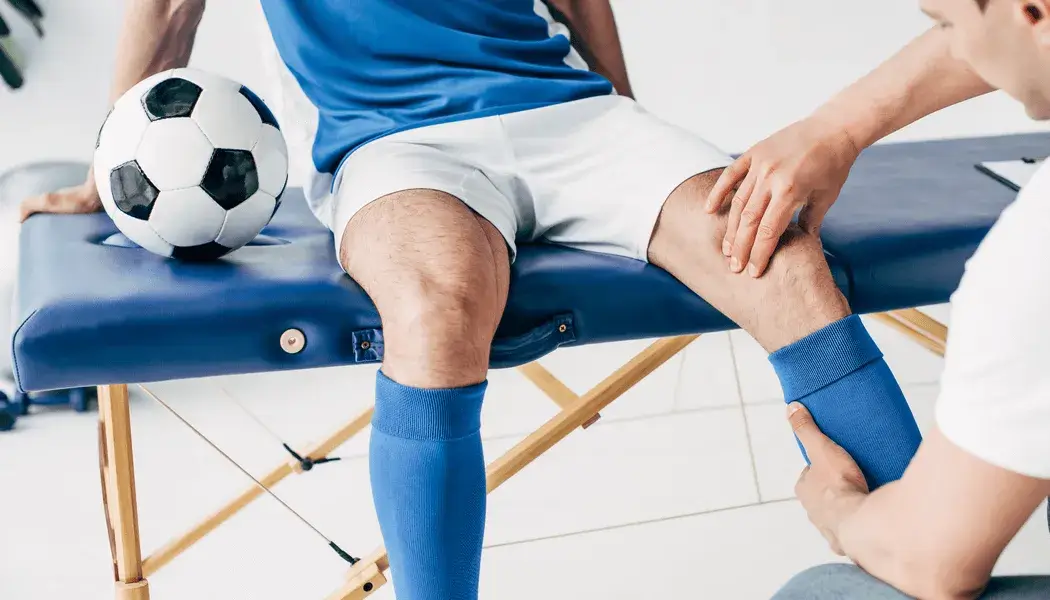Did you injure your knee six months ago but still struggle with persistent pain? Or maybe you’ve received a knee osteoarthritis diagnosis, which explains the pain–but you still struggle to manage it? Physiotherapy for knee pain could be the solution you’re looking for!
Your knee is one of the most complex joints in your body. It’s a hinge joint built of four different bones and an elaborate structure of ligaments and muscles that allows you to walk, run, squat, jump, and much more. But because of this complexity, knee pain is common.
When managing chronic knee pain, the first step is to identify a potential source–which can be trickier than it sounds! Chronic pain is any pain that lasts for over three months, the amount of time it takes most injuries to heal. For this reason, chronic pain may have its root in an injury, but the injury is no longer the reason you’re experiencing pain.
However, some people experience ongoing knee pain due to an underlying chronic condition, such as knee osteoarthritis. Osteoarthritis is caused by the degeneration of cartilage and bone tissue in an affected joint, and it’s the most common form of arthritis in Canada. While it can affect any joint, knees are among the most common.
Addressing chronic knee pain will vary depending on the source of the pain. At Raynen Therapies, our physiotherapists will work with you to learn more about your chronic knee pain and to provide a customized program to help manage (or, in some cases, resolve it).
Ready to learn more about physiotherapy for knee pain? Keep reading!
Different Types of Knee Pain
Because your knee joint is so complex, there’s a lot that potentially can go wrong–and a lot that can cause pain. Here’s a quick overview of the different types of knee pain:
- Ligament Injury: Tearing or overstretching one of the four ligaments in the knee is one of the more common sources of knee pain. These injuries can occur when you twist your knee or suffer a blow to your knee.
- Kneecap Pain: You’ll feel this pain around your kneecap (at the front of your knee). It occurs when the kneecap gets shifted out of place, often due to repeated movements.
- Lateral Knee Pain: You’ll feel this knee pain along the outside of your knee. As with kneecap pain, it’s a type of overuse injury and occurs when one of the knee’s tendons becomes irritated.
- Knee Osteoarthritis: While the other types of knee pain result from injuries to the knee joint’s structure, osteoarthritis is a chronic health condition that damages the cartilage and bone tissue in the knee. Pain from osteoarthritis develops gradually and is often felt on the inner part of the knee. You might also experience swelling and a restricted range of motion.
For people with chronic knee pain who do not have osteoarthritis, their pain may have spread beyond just the site of the original injury. Chronic pain occurs because the brain’s pain centers keep sending messages to the body even though there’s no longer any underlying tissue damage. The pain often feels widespread–many people with chronic pain report feeling as if everything hurts, not just their knee.
It’s also important to remember that many of these knee injuries may require surgical intervention. Some people with chronic knee pain may not have healed properly from their surgery, leading to pain and restricted mobility.
How Physiotherapy Helps Address Knee Pain
No matter what type of knee pain you’re experiencing, the physiotherapists at Raynen Therapies will develop a personalized treatment program that addresses your needs. While the details of the plan will vary, our therapists will address four main areas:
- Pain Management: We’ll help provide immediate pain relief through manual therapy, a set of hands-on techniques that promote mobility and reduce pain. For chronic knee pain, we might try knee mobilizations, in which we gently guide your knee through its current range of motion, although other techniques are at our disposal, too.
- Range of Motion: Mobility restriction usually accompanies knee pain, making it more difficult to exercise and get moving. In addition to manual therapy mobilization techniques, we’ll also show you simple stretching exercises to help restore the range of motion in your knee–as well as your hips, ankles, and feet, as doing so can help relieve pain throughout your lower body.
- Strength: Weak hip and knee muscles contribute to knee pain and instability. By strengthening the muscles around your knee, you provide more support to the joint, helping to relieve pressure–and pain. Strengthening the hip can help ensure proper movement and stability and reduce pressure through the knee joint. Finally, overall strength is critical–strong core, hip, and leg muscles can all contribute to knee pain relief.
- Functionality: As your pain levels decrease, it’s important that you learn to move correctly so that you don’t relapse. Our therapists will examine your walking patterns and posture and suggest exercises to correct any issues. We can also help you relearn how to do movements that might have been challenging for you before you found relief.
Explore the Benefits of Physiotherapy for Knee Pain Today!
Chronic knee pain can dramatically affect your quality of life, making it challenging to spend time with friends, enjoy your favorite activities, or complete everyday tasks. Physiotherapy for knee pain helps you get your life back with a customized therapeutic exercise program and targeted pain relief.
To learn more about how Raynen Therapies can help you manage long-term knee pain, request an appointment at our Scarborough clinic today.
Sources:
Tags: Physiotherapy, Physiotherapist, Knee pain relief, knee pain




